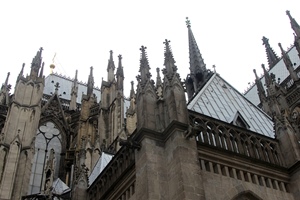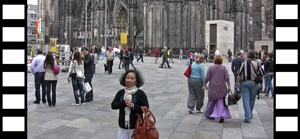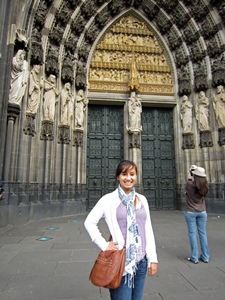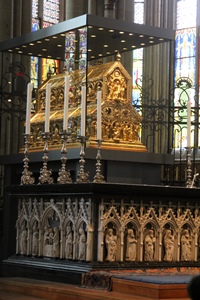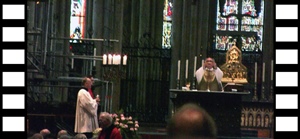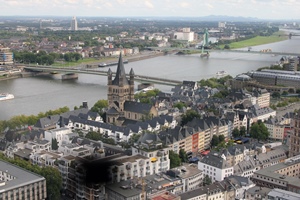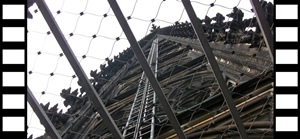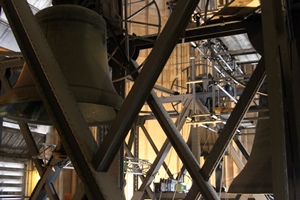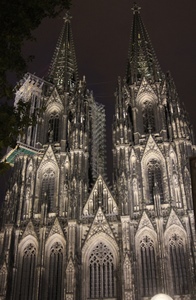We next turned our attention to the Cologne structure which a visitor is least able to ignore, the Cologne Cathedral. Refraining from ignoring the Cathedral is a popular activity in Germany – the Cathedral is Germany’s most-visited landmark by a comfortable margin, attracting more than double the visitors of the second-most-visited landmark, the Reichstag building in Berlin. And one could hardly ignore the building, even if one wanted to – it’s right next to the train station, and it’s really big.
Standing near the Cathedral (Hohe Domkirche St. Petrus, or High Cathedral of St. Peter), one gets the impression of a structure that’s extremely vertical. It is in fact taller than it is long, and at 474 feet, it’s not exactly short. Its height, 516 feet, made it the tallest structure in the world when its towers were completed in 1880 (beating out the cathedral in Rouen, 495 feet). It didn’t enjoy this distinction for long, being surpassed in 1884 by the Washington Monument with its 555 feet, and in 1889 by the Eiffel Tower, which approached 1000 feet. But the Cologne Cathedral remained the world’s tallest "building" (as opposed to "structure") until 1890, when the spire of the Minster in Ulm was completed (530 feet). In ten years the Cathedral had gone from tallest structure in the world to second-tallest church in Germany. But it’s still really tall, and its height makes for a lot of stairs for anyone rash enough to attempt climbing it (see below).
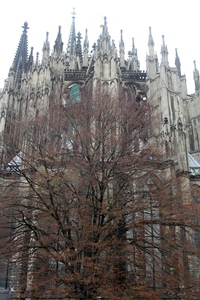
Tree and Cathedral Med Lrg Xlg |

Cathedral from Southwest Med Lrg |
Until the 19th Century, that is. This was the Romantic Era, and people became interested in seeing the project completed. The towers were exactly like they’d been in 1473, including being surmounted by the crane, but interest was high, the plans for the west end of the church were rediscovered, and enough money was raised through a civic effort (and the Prussian government, trying to ingratiate themselves with their newly-acquired Catholic countrymen, kicked in some cash too) to restart construction. As mentioned above, the towers were completed in 1880. This was a national event, with a celebration attended by Kaiser Wilhelm I.
During World War II, the Cathedral received a few bombs, but ended up largely undamaged, at least compared to the rest of the city, which was leveled. It is thought that Allied bomber pilots were interested in preserving it as a prominent navigation point on the way into Germany.
Our assault on the Cathedral began with us gawking at its western façade.

Connie and Nella and Cathedral Med Lrg Xlg |

Cathedral Med Lrg Xlg |
There are three doorways on this side of the church. One of the portals (the one on the right) dates back to the 14th Century, but the other two are 19th Century.
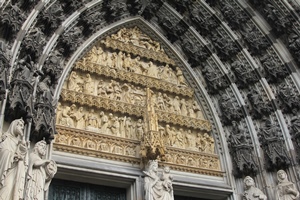
Above the Main Portal Med Lrg Xlg |
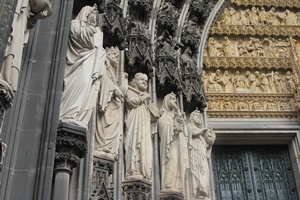
Statues, Main Portal Med Lrg Xlg |

13th Station of the Cross (Wilhelm Mengelberg, 19th C.) Med Lrg Xlg |

Connie and Candles Med Lrg |
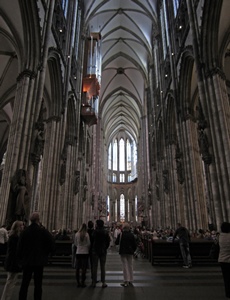
Central Nave Med Lrg |

Central Nave MP4-Sml MP4-Med WMV-HD |
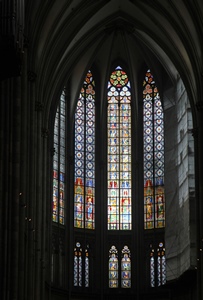
Apse Windows Med Lrg Xlg |
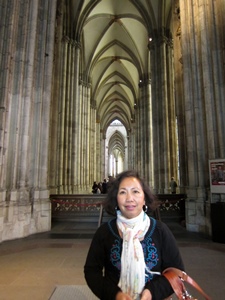
Nella and Northern Aisle Med Lrg |

Magi Window (1507-08) Med Lrg Xlg |
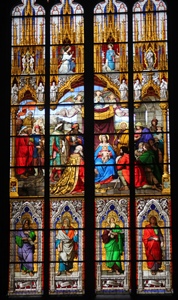
Adoration Window (1846) Med Lrg Xlg |

Lamentation Window (1847) Med Lrg Xlg |

Pentecost Window (1848) Med Lrg Xlg |

St. Peter and Jesse Window (1509) Med Lrg Xlg |
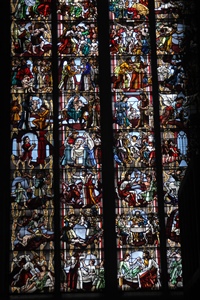
Children of Cologne Window (1960-65) Med Lrg Xlg |

Nave Organ (1998) Med Lrg Xlg |

North Transept Organ (1948-56) Med Lrg Xlg |

Gero Crucifix (ca. 970) Med Lrg Xlg |
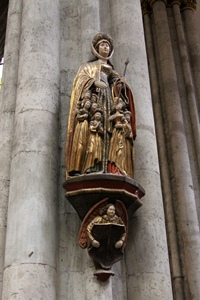
Figure of St. Ursula Med Lrg Xlg |
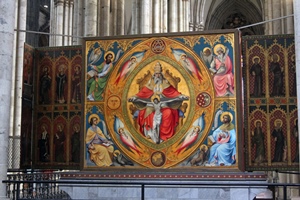
Altar of the Poor Clares (back side) Med Lrg Xlg |
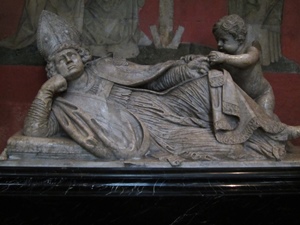
St. Engelbert, Heribert Neuss (1665) Med Lrg |
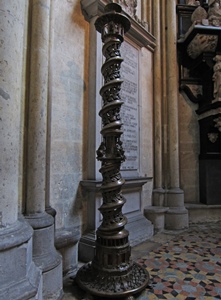
Large Candlestick Med Lrg |

Floor Mosaic with Old Cathedral Med Lrg Xlg |
There were a number of altars in the church. One, the Magi Altar, holds a depiction of the Virgin and Child covered in a large white garment. The garment is covered in jewelry.
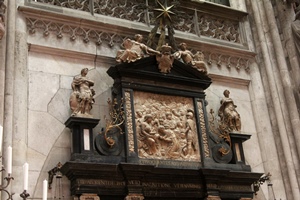
Top of Altar Med Lrg Xlg |
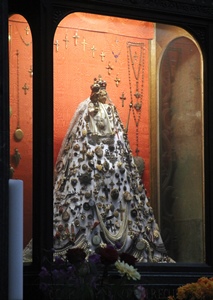
Jewellery Madonna Med Lrg Xlg |
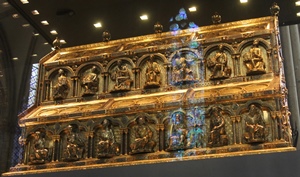
Shrine of the Three Kings, David Side Med Lrg Xlg |
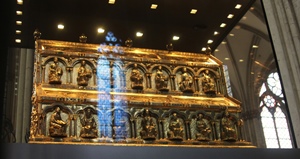
Shrine of the Three Kings, Solomon Side Med Lrg Xlg |
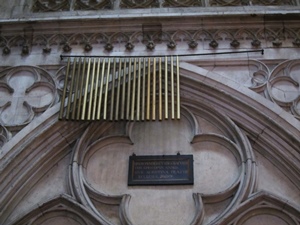
Rods Above Treasury Entrance Med Lrg |
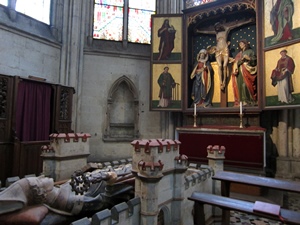
Tomb of Archbishop Philipp of Heinsberg (ca. 1300) Med Lrg |
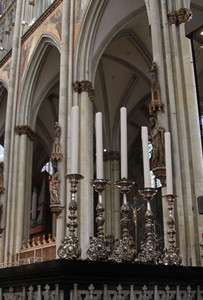
Candles and Candlesticks Med Lrg Xlg |
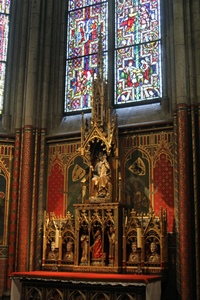
Magi Altar (Wilhelm Mengelberg, 1892) Med Lrg Xlg |
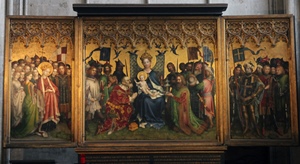
Altar of the City Patrons (ca. 1442) Med Lrg Xlg |
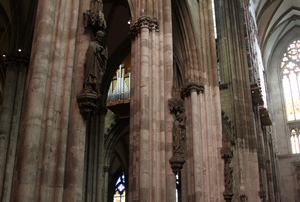
Columns, Statues and Organ Med Lrg Xlg |

St. Hubertus Med Lrg Xlg |
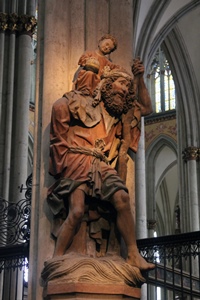
St. Christopher (Tilman van der Burch, ca. 1470) Med Lrg Xlg |
Common to Catholic churches, we found elaborately carved stations of the cross distributed throughout the Cathedral. They were carved in the 19th Century. We’d seen the thirteenth station as we entered, but there were many others.
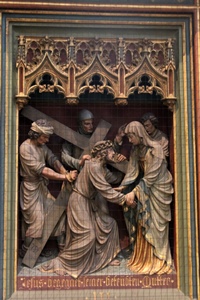
Way of the Cross, Fourth Station Med Lrg Xlg |
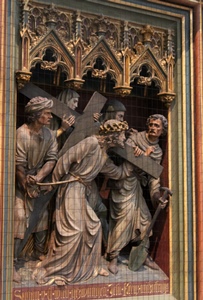
Way of the Cross, Fifth Station Med Lrg Xlg |
Following our exploration of the church, Nella had the good sense to return to the hotel to get some rest. But Connie and I were taken with the idea of exploring one of the towers. We followed the signs to the way up and started our ascent of a whole lot of stairs. At first the stairs were of stone and dark, but eventually they emerged into a sunlit area at the base of the south tower. We paused to catch our breath and contemplate the continuation of the stairway, a modern metallic staircase that rose up the axis of the hollow tower.

Stairway to Top MP4-Sml MP4-Med WMV-HD |

Preparing for Ascent MP4-Sml MP4-Med WMV-HD |

Window in Tower Med Lrg Xlg |

Inside of Tower Med Lrg Xlg |
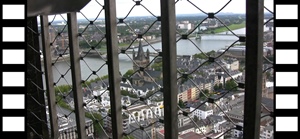
Walkway and View from Top MP4-Sml MP4-Med WMV-HD |

Rhine River and Hohenzollern Bridge Med Lrg Xlg |
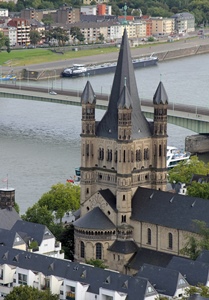
Gross St. Martin Church Med Lrg Xlg |
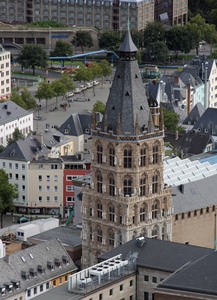
Tower of Town Hall Med Lrg Xlg |
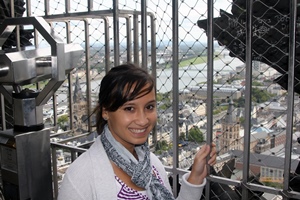
Connie Med Lrg Xlg |

Bob Med Lrg |

View to the Northwest Med Lrg |
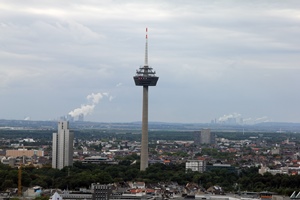
Colonius Telecommunications Tower Med Lrg Xlg |

Connie and Graffiti Med Lrg Xlg |
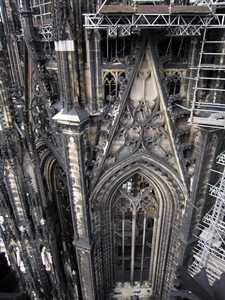
View of North Tower Med Lrg |

Ceiling of Belfry Med Lrg |
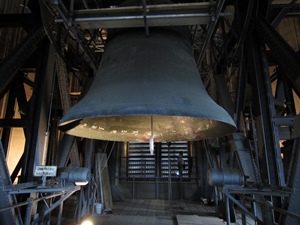
"Fat Peter" Med Lrg |
Continuing downward, we followed a long, tightly-wound spiral staircase which had me walking into a wall when I couldn’t stop turning left at its end. We joined Nella at the hotel and rested for awhile. Eventually we went out and found some dinner, again passing by the Cathedral.
We returned to the hotel and went to sleep, anticipating the next day’s activities, which were to include a cruise along the Rhine.

